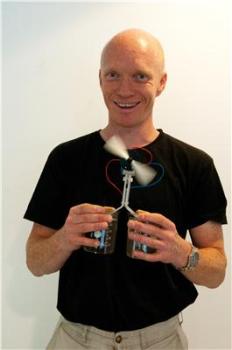The University of Oslo’s Centre for Materials Science and Nanotechnology has entered into a partnership with the Foundation for Scientific and Industrial Research at the Norwegian Institute of Technology (SINTEF) to develop an eco-friendly technology known as thermoelectricity, which can produce electricity from waste heat using temperature differences.
 Ole Martin Lovvik demonstrates themoelectricity with one glass of cold and one glass of hot water. The new technology utilizes the temperature difference and generates enough energy to operate a rapidly rotating fan. Credit: Yngve Vogt
Ole Martin Lovvik demonstrates themoelectricity with one glass of cold and one glass of hot water. The new technology utilizes the temperature difference and generates enough energy to operate a rapidly rotating fan. Credit: Yngve Vogt
The research team is now working on the development of low-cost and pollution-free materials that can save up to 15% of all energy wastages, which is 50% higher than the recoverability of existing technologies. The nanoscience-based technology will first be deployed in thermoelectric generators used in cars. It can also redesign and advance current refrigerators.
An efficient thermoelectric material must be a semi-conductor having good electrical conductivity and high thermal resistance. When a material is heated, its atoms get vibrated to produce heat waves, resulting in the dissipation of heat. The creation of barriers inside the material will allow atoms to vibrate at various frequencies against their neighboring atoms, which in turn restricts heat dissipation. However, the barriers do not have an impact on the flow of electric current.
The research team has developed an innovative process for the creation of these atomic barriers, which are created densely within the semiconductors. Ole Martin Lovvik, one of the researchers, stated that the research team used an entirely new ‘mill’ to create the barriers. The team ground down the semi-conductor materials into nanoscale grains by cooling them to a temperature of -196° C using liquid nitrogen, which makes them less sticky, more brittle and easy to crush. The grains are then bonded together again, resulting in the creation of atomic barriers whose tiny imperfections reflect the heat waves, Lovvik said.
The research team utilized an electron microscope to study the material’s nano-cavities. The Norwegian Micro and Nano Laboratories, which are operated jointly by SINTEF and the University of Oslo measure the thermal resistance in the material. The research team is striving to discover future-generation thermoelectric materials and has just examined skutterudite, a mineral of cobalt arsenide. During the test, the research team found that atoms of skutterudite are situated in nano-cavities, which can prevent heat dissipation by acting as atomic barriers, Lovvik concluded.